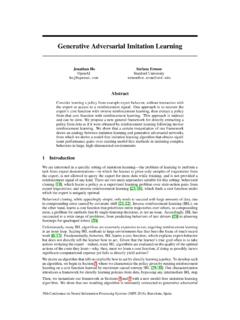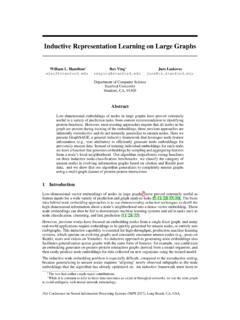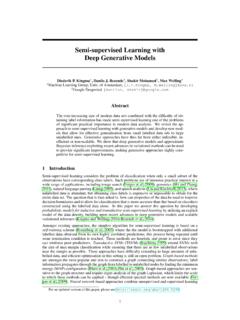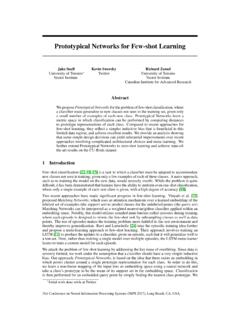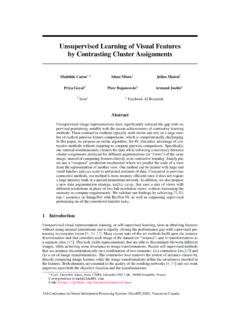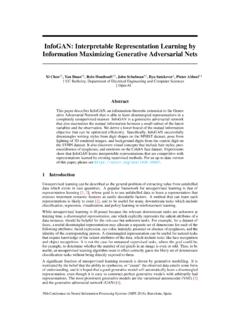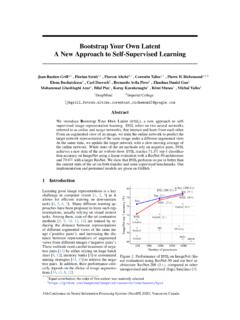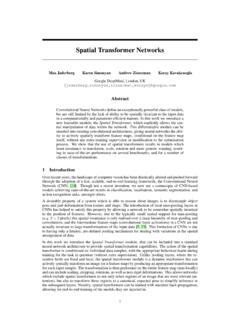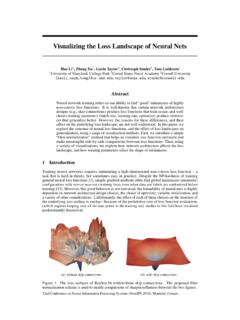Transcription of PyTorch: An Imperative Style, High-Performance Deep ...
1 pytorch : An Imperative Style, High-PerformanceDeep learning LibraryAdam PaszkeUniversity of GrossFacebook AI MassaFacebook AI LererFacebook AI ChananFacebook AI KilleenSelf LinFacebook AI DesmaisonOxford K YangFacebook AI DeVitoFacebook AI SteinerFacebook AI ChintalaFacebook AI learning frameworks have often focused on either usability or speed, butnot both. pytorch is a machine learning library that shows that these two goalsare in fact compatible: it provides an Imperative and Pythonic programming stylethat supports code as a model, makes debugging easy and is consistent with otherpopular scientific computing libraries, while remaining efficient and supportinghardware accelerators such as this paper, we detail the principles that drove the implementation of PyTorchand how they are reflected in its architecture. We emphasize that every aspect ofPyTorch is a regular Python program under the full control of its user.
2 We alsoexplain how the careful and pragmatic implementation of the key components ofits runtime enables them to work together to achieve compelling demonstrate the efficiency of individual subsystems, as well as the overallspeed of pytorch on several common Conference on Neural Information Processing Systems (NeurIPS 2019), Vancouver, IntroductionWith the increased interest in deep learning in recent years, there has been an explosion of machinelearning tools. Many popular frameworks such as Caffe [1], CNTK [2], TensorFlow [3], andTheano [4], construct a static dataflow graph that represents the computation and which can then beapplied repeatedly to batches of data. This approach provides visibility into the whole computationahead of time, and can theoretically be leveraged to improve performance and scalability. However, itcomes at the cost of ease of use, ease of debugging, and flexibility of the types of computation thatcan be work has recognized the value of dynamic eager execution for deep learning , and some recentframeworks implement this define-by-run approach, but do so either at the cost of performance(Chainer [5]) or using a less expressive, faster language (Torch [6], DyNet [7]), which limits , with careful implementation and design choices, dynamic eager execution can be achievedlargely without sacrificing performance.
3 This paper introduces pytorch , a Python library thatperforms immediate execution of dynamic tensor computations with automatic differentiation andGPU acceleration, and does so while maintaining performance comparable to the fastest currentlibraries for deep learning . This combination has turned out to be very popular in the researchcommunity with, for instance, 296 ICLR 2019 submissions mentioning BackgroundFour major trends in scientific computing have become increasingly important for deep , starting in the 1960s, the development of domain specific languages such as APL [8], MATLAB[9], R [10] and Julia [11], turned multidimensional arrays (often referred to as tensors) into first-classobjects supported by a comprehensive set of mathematical primitives (or operators) to manipulatethem. Separately, libraries such as NumPy[12], Torch[6], Eigen[13] and Lush[14] madearray-basedprogrammingproductive in general purpose languages such as Python, Lisp, C++ and , the development ofautomatic differentiation[15] made it possible to fully automatethe daunting labor of computing derivatives.
4 This made it significantly easier to experiment withdifferent machine learning approaches while still allowing for efficient gradient based autograd [16] package popularized the use of this technique for NumPy arrays, and similarapproaches are used in frameworks such as Chainer [5], DyNet [7], Lush [14], Torch [6], Jax [17]and [18].Third, with the advent of the free software movement, the scientific community moved away fromclosed proprietary software such as Matlab[9], and towards theopen-source Python ecosystemwith packages like NumPy [12], SciPy [19], and Pandas [20]. This fulfilled most of the numericalanalysis needs of researchers while allowing them to take advantage of a vast repository of librariesto handle dataset preprocessing, statistical analysis, plotting, and more. Moreover, the openness,interoperability, and flexibility of free software fostered the development of vibrant communities thatcould quickly address new or changing needs by extending the existing functionality of a library or ifneeded by developing and releasing brand new ones.
5 While there is a rich offering of open-sourcesoftware for neural networks in languages other than Python, starting with Lush [14] in Lisp, Torch [6]in C++, Objective-C and Lua, EBLearn [21] in C++, Caffe [1] in C++, the network effects of a largeecosystem such as Python made it an essential skill to jumpstart one s research . Hence, since 2014,most deep learning frameworks converged on a Python interface as an essential , the availability and commoditization of general-purpose massively parallel hardware suchas GPUs provided the computing power required by deep learning methods. Specialized librariessuch as cuDNN [22], along with a body of academic work (such as [23] and [24]), produced aset of High-Performance reusable deep learning kernels that enabled frameworks such as Caffe [1],Torch7 [25], or TensorFlow [3] to take advantage of thesehardware builds on these trends by providing an array-based programming model accelerated by GPUsand differentiable via automatic differentiation integrated in the Python Design principlesPyTorch s success stems from weaving previous ideas into a design that balances speed and ease ofuse.
6 There are four main principles behind our choices:Be PythonicData scientists are familiar with the Python language, its programming model, and itstools. pytorch should be a first-class member of that ecosystem. It follows the commonly establisheddesign goals of keeping interfaces simple and consistent, ideally with one idiomatic way of doingthings. It also integrates naturally with standard plotting, debugging, and data processing researchers firstPyTorch strives to make writing models, data loaders, and optimizers aseasy and productive as possible. The complexity inherent to machine learning should be handledinternally by the pytorch library and hidden behind intuitive APIs free of side-effects and unexpectedperformance pragmatic performanceTo be useful, pytorch needs to deliver compelling performance,although not at the expense of simplicity and ease of use. Trading 10% of speed for a significantlysimpler to use model is acceptable; 100% is not.
7 Therefore, itsimplementationaccepts addedcomplexity in order to deliver that performance. Additionally, providing tools that allow researchersto manually control the execution of their code will empower them to find their own performanceimprovements independent of those that the library provides is better[26]Given a fixed amount of engineering resources, and all else being equal, thetime saved by keeping the internal implementation of pytorch simple can be used to implementadditional features, adapt to new situations, and keep up with the fast pace of progress in the field ofAI. Therefore it is better to have a simple but slightly incomplete solution than a comprehensive butcomplex and hard to maintain Usability centric Deep learning models are just Python programsIn a surprisingly short amount of time, machine learning grew from recognizing individual digits [27]into autonomously playing StarCraft [28].
8 Consequently, the neural networks themselves evolvedrapidly from simple sequences of feed forward layers into incredibly varied numerical programsoften composed of many loops and recursive functions. To support this growing complexity, PyTorchforegoes the potential benefits of a graph-metaprogramming based approach to preserve the imperativeprogramming model of Python. This design was pioneered for model authoring by Chainer[5] andDynet[7]. pytorch extends this to all aspects of deep learning workflows. Defining layers, composingmodels, loading data, running optimizers, and parallelizing the training process are all expressedusing the familiar concepts developed for general purpose solution ensures that any new potential neural network architecture can be easily implementedwith pytorch . For instance, layers (which in modern machine learning should really be understoodas stateful functions with implicit parameters) are typically expressed as Python classes whoseconstructors create and initialize their parameters, and whose forward methods process an inputactivation.
9 Similarly, models are usually represented as classes that compose individual layers, but letus state again that nothing forces the user to structure their code in that way. Listing 1 demonstrateshow an entire model can be created by composing functionality provided by pytorch such as 2dconvolution, matrix multiplication, dropout, and softmax to classify gray-scale images. Note thatlinear layers are of course part of the library, but we show an example implementation to highlighthow simple it LinearLayer(Module):class FullBasicModel( ):def__init__(self, in_sz, out_sz):def__init__(self):super().__init __() super().__init__()t1 = (in_sz, out_sz) = (1, 128, 3) = (t1) = LinearLayer(128, 10)t2 = (out_sz) = (t2)defforward(self, x):t1 = (x)defforward(self, activations): t2 = (t1)t = (activations, ) t3 = (t1)returnt + (t3)Listing 1:A custom layer used as a building block for a simple but complete neural everything is a just a program philosophy is not limited to just the models, and applies tooptimizers and data loaders as well.
10 This facilitates the experimentation of new training example, to implement the very popular generative adversarial networks, one needs to specifytwo separate models (the generator and the discriminator), and two loss functions that depend on bothmodels at the same time. Rigid APIs would struggle with this setup, but the simple design employedin pytorch easily adapts to this setting as shown in Listing = create_discriminator()generator = create_generator()optimD = ( ())optimG = ( ())defstep(real_sample):# (1) Update DiscriminatorerrD_real = loss(discriminator(real_sample), real_label) ()fake = generator(get_noise())errD_fake = loss(discriminator( (), fake_label) () ()# (2) Update GeneratorerrG = loss(discriminator(fake), real_label) () ()Listing 2:Simplified training of a generative adversarial pytorch programs execute eagerly, all the features of Python are available throughout thewhole design process.)
